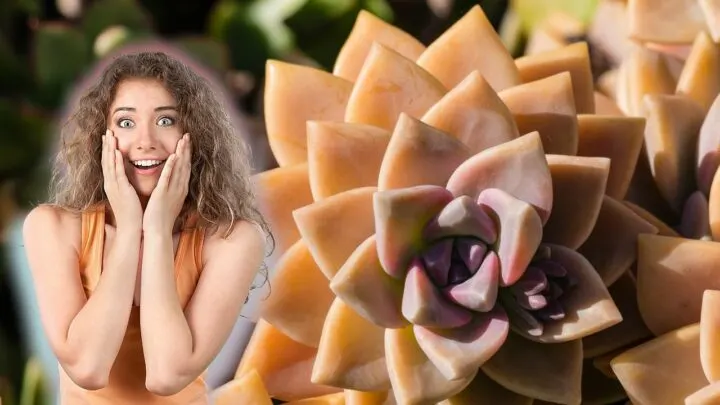There’s something about orange succulents that just makes them look exquisite. They’re not overly bright like yellow ones, and they’re not so much “in your face” as fiery red counterparts.
Instead, they have just the right amount of brightness, enough to bring some cheer into a landscape or interior space. They also work well in combinations with differently-colored succulents.
Have you been thinking about adding an orange succulent to your plant collection? We can help! We’ve scoured the web and compiled a list of the 9 prettiest orange succulents. Let’s dig in.
Table of Contents
Which are the prettiest orange succulents?
- Peanut cactus
- Graptosedum ‘California Sunset’
- Lithops karasmontana
- Sedum nussbaumerianum ‘Coppertone Stonecrop’
- Mammillaria elongata cristata ‘Copper King’
- Sedum adolphii ‘Golden Sedum’
- Begonia boliviensis
- Echeveria ‘Orange Monroe’
- Graptoveria ‘Fred Ives’
1. Peanut cactus
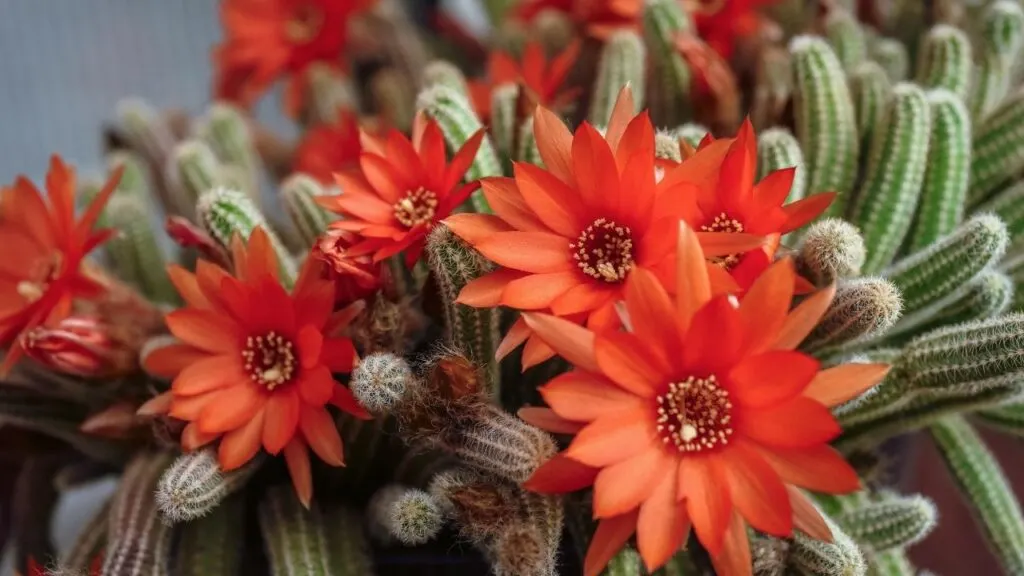
Scientifically known as “Echinopsis chamaecereus”, Peanut cactus is a gorgeous low-growing plant. It consists of tiny white spines, which encase the 6 to 9 ridges along the stems.
Speaking of stems, they make up one of the most stunning parts of this plant. They’re shaped like fingers or long peanuts; hence the name. Plus, they can grow up to a height of 6 inches and 12 inches wide.
During late spring to early summer, the peanut plant produces massive, gorgeous flowers with a reddish-to-orange hue. These blooms cover a considerable portion of the cactus, helping it to really stand out.
For the best care, consider exposing this plant to the sun gradually to avoid scorching its leaves. Peanut cactus is also highly susceptible to rot, so you’ll want to be extra careful when watering.
In spring and summer, water only when the top inch or two of the potting mix dries out. But in winter, you can leave it alone completely. The only time that warrants watering in winter is if it’s not being kept in a cool spot; at temperatures at or below 40°F (5°C).
The Peanut cactus is easy to propagate from its stem cutting. Plant this in a well-draining growing medium and water whenever necessary.
2. Graptosedum ‘California Sunset’
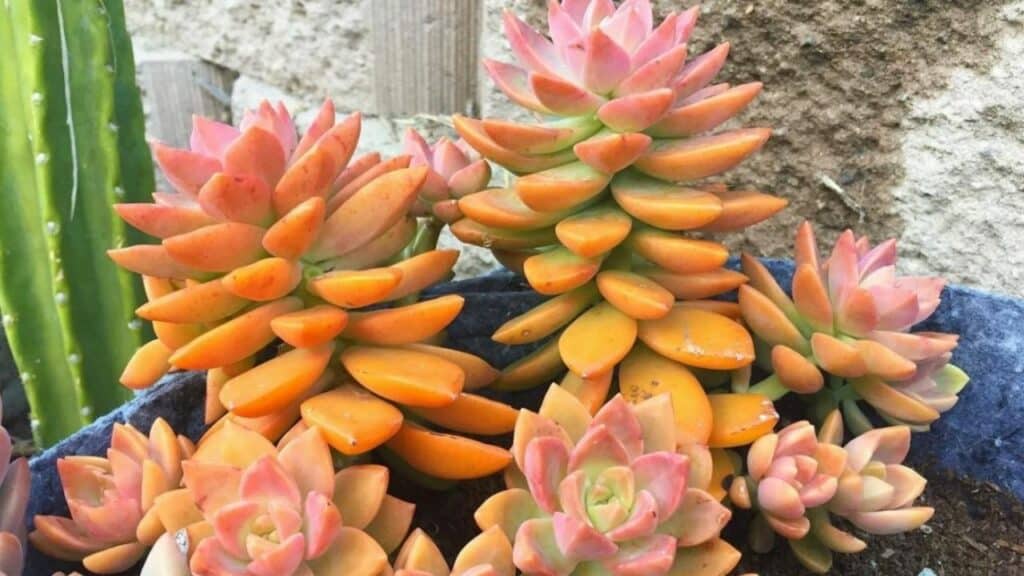
Photo Credit: @seagreenscapes on Instagram!
Popularly referred to as “California Sunset”,this is an easy-to-care-for succulent with rosy orange foliage creating small rosettes like those you often see in Echeverias.
This plant’s stems assume a long and leggy structure, giving it a distinct look. New growth takes up a shade of gray to green, but you can achieve the orange color by exposing the plant to winter-cool temperatures.
Graptosedum flowers in the period between spring and summer. During this period, it produces clusters of white, heart-shaped flowers.
This succulent thrives in a fast-draining potting mixture, which can be amended with coarse sand, pumice or perlite to improve drainage and aeration.
You’ll also need to water it, but not too frequently. After all, California Sunset can survive a little bit of neglect.
When it comes to temperature, Graptosedum thrives in partial to full sun. Providing it with a few hours of morning sun is ideal. And in case you’re growing it outdoors, be sure to bring it in indoors if the temperatures drop below 30°F (-1.1°C).
Regrowing this plant is fairly easy, and you can do so using either stem or leaf cuttings. If you opt for leaf cuttings, be careful not to leave a part of it behind as this reduces its chance of regrowing.
3. Lithops karasmontana
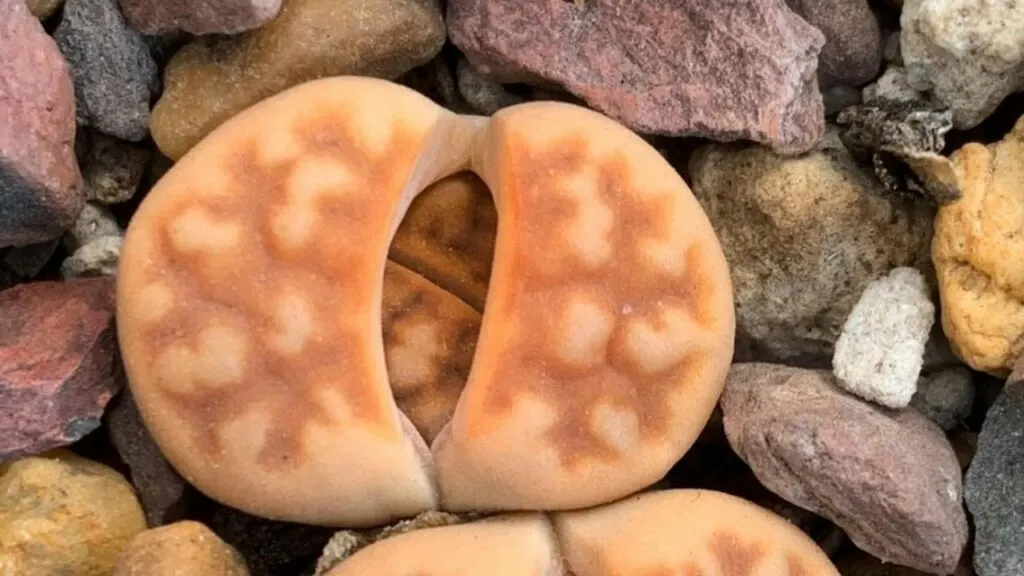
Photo Credit: @migratorymaniscorry on Instagram!
Native to South Africa, Lithops karasmontana has a bold and vibrant coloration that is sure to draw attention wherever it’s placed.
It has a low profile, growing 18 inches tall at most, with a spread of 5 ft. It contains three-sided leaves, which are pale green in color, and produces bright orange flowers with distinct yellow centers.
Like the majority of ice plants, Lithops karasmontana has modest requirements, especially when it comes to watering. Its thick leaves store plenty of water, so you don’t need to water it frequently.
In fact, you should wait until the top inch of the soil has dried up to water.
In terms of lighting, this plant thrives in full sun. This not only helps its flowers to open fully but it also prevents it from becoming leggy.
Another hack that contributes to its healthy growth is pruning. After the spring bloom period, try cutting it back so as to eliminate the fruit capsules and encourage more growth.
Looking for a way to propagate your orange ice plant? Well, you have numerous options to pick from. You can use the division method, cuttings or seeds.
If you decide to divide the plant, the best time to propagate is spring to increase its chances of survival.
Cuttings offer you a little more flexibility as they can be rooted at any time in the growing season.
If you choose seeds, all you’ll have to do is scatter them in your garden. Ensure they’re not covered to help them receive ample light to germinate.
4. Sedum nussbaumerianum ‘Coppertone Stonecrop’
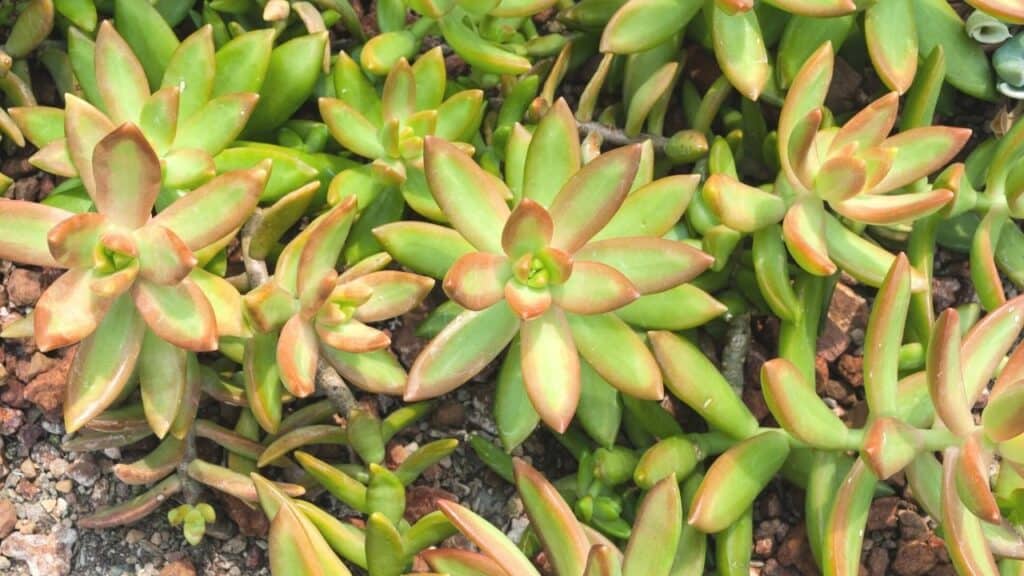
The Coppertone stonecrop may have one of the hardest names to pronounce, but it has a pretty laid-back vibe.
Native to Mexico, this succulent grows up to 8 inches tall. However, it spreads quite wide, reaching 2 to 3 feet across.
This plant’s leaves are long and plump. They come in different colors depending on the intensity of light. If exposed to minimal light, they retain a yellow-to-green color.
But in full sun, they turn into a coppery-orange shade. That said, you’ll need to be careful not to to expose it to very intense light as it can burn this beautiful foliage.
Taking its colorful look and spread into account, the Coppertone Stonecrop makes for an excellent ground-cover plant. If you’re growing your sedum indoors, it will look really pretty in a hanging basket or a plant combo container.
And the best part is, it has very few needs. The biggest factor you’ll need to consider is how well the soil drains. You don’t want to leave this plant sitting in water for too long as this will likely lead to rot.
So consider planting in a gritty mix, and use a pot with drainage holes. On the same note, water less frequently, especially during winter when the plant goes dormant.
5. Mammillaria elongata cristata ‘Copper King’
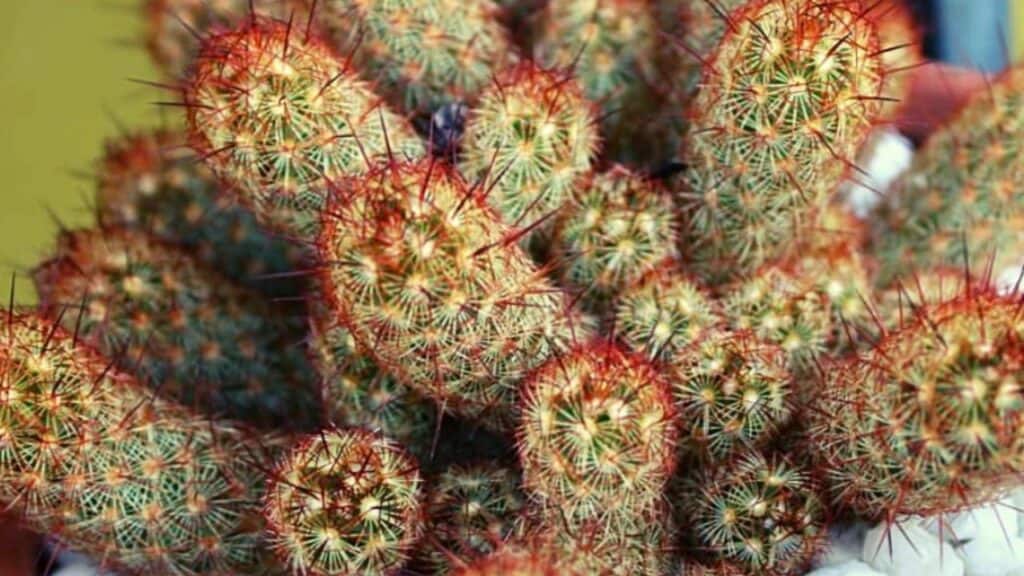
Photo Credti: @luvinsuccs on Instagram!
If you’re looking to add more vibrant plants in your garden, the Mammillaria elongata is the perfect option. It stands quite tall, up to 6 inches, and has a cylindrical shape.
But what makes this plant pop is the covering on its stem, which comprises short, orange-copper spines. These contrast beautifully with the cactus’ pale-yellow to pink flowers.
In terms of care, it’s best to plant your Copper King in a well-draining cactus mix. This ensures that water is not left standing at the plant’s base, which would encourage rotting.
If you notice that the water isn’t draining well, you can always add mineral grit such as perlite or pumice.
The technique you use to water also matters when caring for this gorgeous orange plant. You want to water deeply then wait for this potting mixture to completely dry out prior to rewatering.
Mammillaria elongata is not the kind of plant that can survive a hard frost. It means that if you’ve planted yours outdoors, always bring it inside if the temperatures drop too low. Once indoors, you can grow it near a sunny windowsill or under a grow light.
6. Sedum adolphii ‘Golden Sedum’
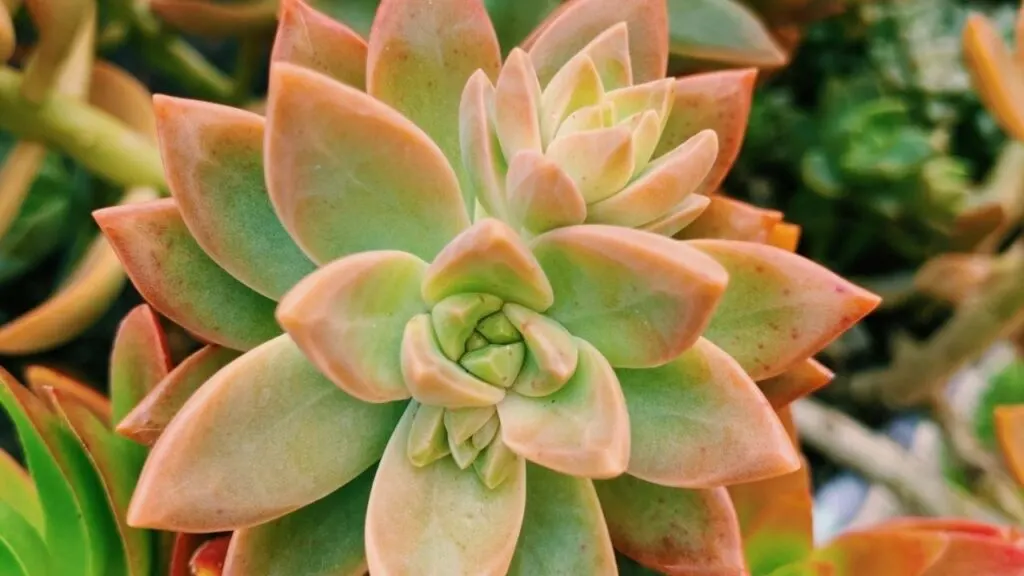
Sedum adolphii is more easily identified as the Golden Sedum. It’s a tender succulent, which once mature, attains a height of about 8 inches. It’s best used as ground cover, as it forms rosettes of part green part yellow leaves that reach up to 1.4 inches long.
This plant turns into an orange hue when it’s exposed to a decent amount of sunlight. But what I found even more intriguing is its blooming pattern.
In early spring, you’ll notice that it produces white flowers with pink-like anthers. These flowers usually appear in succession so while some are blooming, others will be fading simultaneously.
The watering needs of this plant are identical to those of other succulents. As such, you’ll want to use a soak-deeply-then-dry approach. Ensure that it’s fully dry between waterings to prevent rot.
In terms of light, Golden Sedum fares better in full to partial sun. However, it cannot tolerate a cold, hardy environment. Therefore, it’s better to plant it in a container, which you can easily transfer indoors if the weather takes a turn for the worse.
Propagating the Sedum adolphii is a breeze. Simply cut a healthy stem from the mother plant, plant in a rich, well-draining soil and wait for it to root.
7. Begonia boliviensis
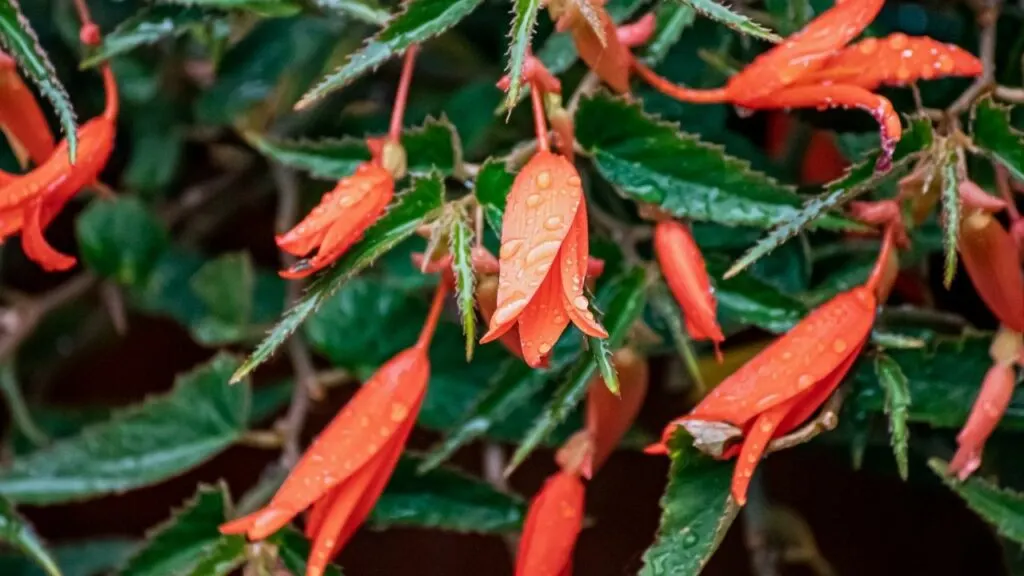
Discovered in the Bolivian Andes, this begonia originates from a tuberous stock, attaining a height of 12 to 18 inches.
It touts a colorful look that is hard to miss. It produces clusters of large, stunning, orange to fiery red flowers, which are held on bright red stems with pale green leaves.
Given its dazzling look, the Begonia boliviensis is the perfect addition to a vertical garden.
For this plant to thrive, it requires a growing medium that is rich, moist and well-draining. It also prefers a partially-shaded spot or exposure to bright, indirect light.
Keep in mind that if you place it in a spot that is completely shaded, it won’t produce as many flowers as it would if it were in a lit area.
Begonias are generally not winter-hardy, and the boliviensis is no exception. So before the first frost occurs, it’s wise to dig up the tubers and store them in a cool dry place. You can then replant when the temperatures are warmer.
You can learn more about Begonia boliviensis here.
8. Echeveria ‘Orange Monroe’
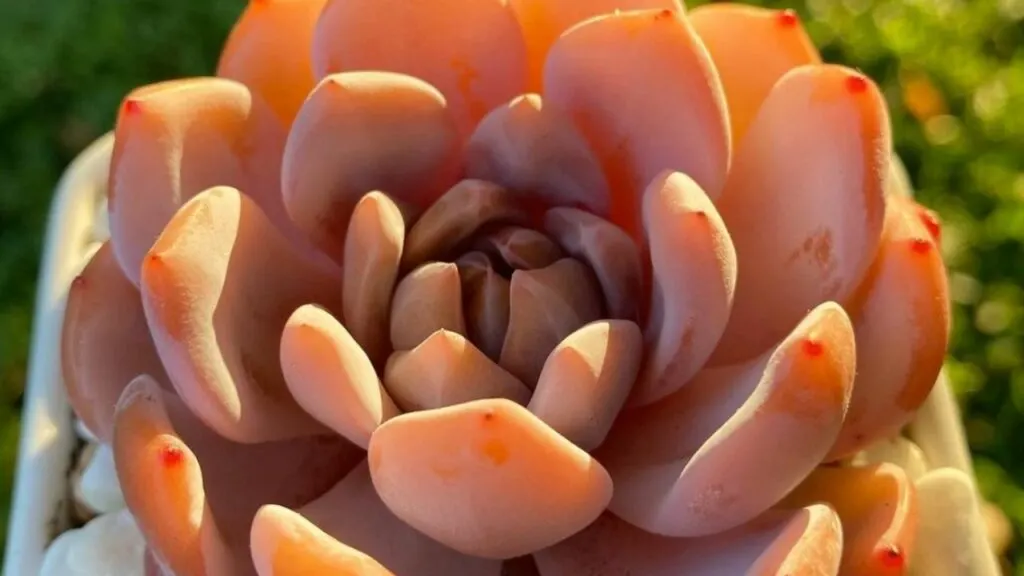
Photo Credit: @simonas.succulents on Instagram!
If you have limited space, but still want to decorate your home with a pretty orange succulent, the Orange Monroe is just what you need.
It’s small and compact, a structure that it achieves by forming a tight rosette of silver-blue foliage. Now, if you want to experience the full splendor of this plant, expose it to strong light.
This enables it to become more vibrant with hints of deep yellow and orange tones.
Growing and maintaining the Echeveria Orange Monroe shouldn’t be difficult as long as you follow a couple of rules. For starters, never overwater or leave it to sit in water as this encourages root rot and fungal diseases.
Secondly, always remove the dead leaves that fall to the base of the plant as it grows.
While you might not think of this as a big deal, leaving the dead leaves to sit there creates a conducive environment for pests.
You’ll also want to plant your Echeveria in a soil that drains well, and water only when necessary.
The Echeveria Orange Monroe is pretty easy to propagate. All you need to do is get a leaf cutting from the mother plant, allow it to form a callus, then plant in a suitable potting mix.
9. Graptoveria ‘Fred Ives’

Another pretty orange that you’ll love adding to your garden is Fred Ives. It’s an evergreen that forms spreading clumps of beautiful rosettes up to 12 inches wide.
The leaves are ultra-thick with pointed bronze tips. Depending on the light intensity, season, and temperature, these leaves take on different colors, ranging from blue to teal, orange or yellow.
In summer, this plant blooms beautifully. It produces pale-yellow flowers, which have red-orange centers. If you want to enjoy its true beauty, expose it to a reasonable amount of light.
Nonetheless, it still remains attractive even when it’s grown in a shaded spot, with its greenish-turquoise hue.
One thing you will love even more is its ease of maintenance. It’s highly drought-tolerant, requiring very little water if any. Also, ensure you plant in a potting mix with good drainage.
A cross between Graptopetalum paraguayense and Echeveria gibbiflora, this succulent grows up to a height of 8 inches. It’s very easy to propagate from its offset.
Once you extract the offset, shake off any excess soil, allow a callus to form then plant in a well-draining soil. You can also use its leaf or stem cuttings for propagation.

Daniel has been a plant enthusiast for over 20 years. He owns hundreds of houseplants and prepares for the chili growing seasons yearly with great anticipation. His favorite plants are plant species in the Araceae family, such as Monstera, Philodendron, and Anthurium. He also loves gardening and is growing hot peppers, tomatoes, and many more vegetables.

